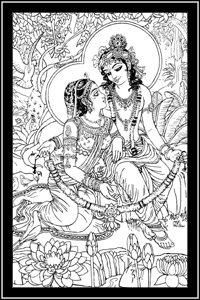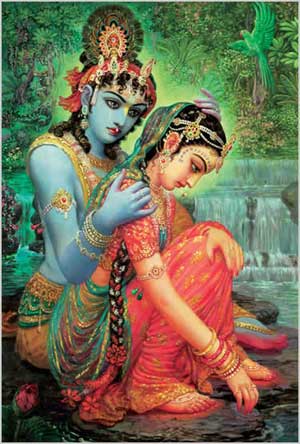

Part 1 -- Sri Kesavaji Gaudiya Matha: August 27, 2009, evening.
[This year, in honor of Sri Radhastami, Srila Bhaktivedanta Narayana Gosvami Maharaja gave two discourses on the glories of Srimati Radhika; one on the eve of Radhastami and one on the following morning. Srila Maharaja spoke in his mother tongue, Hindi, and his words were simultaneously translated by Akhilesh dasa Adhikari into the headphones of the English speaking devotees in the audience.]
“Sri Krsna was present at Vamsivata, the place of the rasa dance, but He was not happy. He wanted to perform loving pastimes but He was all alone. Srimati Radharani then appeared from His left side, and Sankara (Siva), Sri Gopisvara, appeared from His right side as guru-tattva. Radha ran to Krsna with great pleasure. Ra is for anuragi, meaning ‘deep spiritual loving attachment,’ and dha is for dhavati, which means ‘to run very fast, with great eagerness.’ Krsna worshiped that very Radha, and therefore Her name became Radhika.”
When Krsna first appeared in Gokula, Narada came for His darsana and thought, “Krsna never appears alone; His hladini-sakti must also have been born.”
In the meantime, Vrsabhanu Maharaja was staying in Raval, where he daily took bath in the river Yamuna. One day, fifteen days after the birth of Lord Krsna, just after taking his bath, Vrsabhanu Maharaja saw a thousand-petaled lotus flower in the Jamuna. In the middle of that lotus flower was a beautiful baby girl sucking Her thumb and moving Her hands and legs. Seeing Her, he immediately picked Her up, took Her in his arms, brought Her to his wife Kirtika, and placed Her on Kirtika’s lap. Not many people know Radhika as the daughter of Kirtika-devi; they mostly know Her as the dear daughter of Vrsabhanu Maharaja.
Just after the appearance of that baby girl, Narada went to Vrsabhanu Maharaja’s home and inquired from him, “Has there been any child born of you?”
Vrsabhanu Maharaja replied, “Yes, a son called Sridama.”
Narada then blessed Sridama and asked, “Has there been any child born more recently?”
Vrsabhanu Maharaja replied, “Yes, a few days ago a daughter was born; I was blessed with a daughter.”
Narada asked Vrsabhanu Maharaja, “May I see your daughter? I want to do Her chart and bless Her. I will describe Her future qualities. Please gather candana, Yamuna water, and other paraphernalia so that I can perform a ceremony to bless Her.”
Vrsabhanu Maharaja then went inside the house and Narada entered a trance of meditation. While he was meditating, that baby girl manifested an exquisite youthful form. Lalita and Visakha were also present, and Lalita told him, “Why are you continuing to meditate; stand up and offer your obeisances.”
Narada then received a one-moment darsana of Radhika, but because his thirst to see Her was not quenched, he went to Narada-kunda and performed austerities for thousands of years, without eating, and continually chanting Radha mantra-japa. At that time Radharani appeared to Him, gave him Her service, and he became Naradiya gopi. We know these details from sastra.
Srimad-Bhagavatam states, “Ete camsa-kalah pumsah krsnas tu bhagavan svayam – Krsna is the original Supreme Personality of Godhead.” Although Sri Krsna is the supreme worshipful Lord of all, He Himself worships Sri Radha. The aim of the author, Srila Vyasadeva, in manifesting Srimad-Bhagavatam was to describe Sri Krsna’s pastimes with Srimati Radhika and to establish Her glories. Srila Sanatana Gosvami and Srila Visvanatha Cakravarti Thakura say that rasa-lila, the most exalted pastime in Srimad-Bhagavatam, was performed for the sake of Srimati Radhika. Krsna personally told Her, “It is for You that I reside in Vraja.”
sata-koti gopi madhava-man“The flute song calls the name of Radhika – ‘Come here, come here, Radhe!’ Syama calls out in the night. (verse 12)
rakhite narilo kori jatan
(verse 11 of Varaja-vipine)[“Millions of cowherd damsels are unable to please the mind of Madhava although endeavoring to do so.”
“When the sri-rasa-mandala comes to a halt in search of Beloved Radha He then goes. (verse 13)
“Please appear, O Radhe! Kindly save My life!” calling out while weeping Kan in the forest. (verse 14)
“In a secluded grove embracing Radhika regaining His life and soul, Hari is relieved. (verse 15)
“Saying, ‘Without You, where is the rasa dance? Only because of You do I live in Vraja.” (verse 16)
“At the lotus feet of such a Radhika this Bhaktivinoda says weeping, (verse 17)
“’Among Your personal associates please count me also; making me Your maidservant keep me as Your own.’” (verse 18)]
Even though millions of gopis were also present in the arena of rasa, they could not attract Krsna’s mind when Radhika disappeared from rasa-lila. Radharani first disappeared from the rasa-lila, in maan; Krsna did not disappear from there alone. He left the rasa dance to search for Her. Very worried and crying, “Radhe Radhe,” He finally found Her.
The other gopis, who had left the rasa dance to search for Krsna, now saw two sets of footprints. One set was Krsna’s footprints, and the other, smaller and more delicate set belonged to a lady.
Lalita and Visakha and the other gopis of Sri Radha’s party, who had been searching both Radha and Krsna, knew that this second set of footprints belonged to Srimati Radhika. Very pleased, they thought, “Oh, Krsna is not alone; He has taken our prana-priya (dearmost) sakhi with Him. At the same time, however, they were sad, thinking, “We can’t serve Her now, because we are not with Her.”
The other gopis, those who are not in Radha’s party, uttered this verse:
anayaradhito nunam“Oh, this girl who is with Krsna is so fortunate. Krsna has taken Her and has thus broken our pride (saubhagya-mada).” They understood that this girl was superior to them: “She had surely served Narayana and pleased Him, and due to Narayana’s blessing upon Her, Krsna took Her alone.” Thus, Radhika is the topmost of all of Krsna’s beloveds, and rasa-lila was performed in order to establish Her superiority. It was performed for Her pleasure.
bhagavan harir isvarah
yan no vihaya govindah
prito yam anayad rahah[“Certainly this particular gopi has perfectly worshiped the all-powerful Personality of Godhead, Govinda, since He was so pleased with Her that He abandoned the rest of us and brought Her to a secluded place.”
(Srimad-Bhagavatam, 10.30.28)]
After all the gopis sang their song of separation, Krsna appeared to them and uttered this verse:
na paraye 'ham niravadya-samyujam“Oh gopis, for My sake you left your shyness, the instructions of your superiors, and your lives as householders, which were meant to keep you bound. By your saintly nature, may you free Me from My debt.”
sva-sadhu-krtyam vibudhayusapi vah
ya mabhajan durjara-geha-srnkhalah
samvrscya tad vaù pratiyatu sadhuna[“I am not able to repay My debt for your spotless service, even within a lifetime of Brahma. Your connection with Me is beyond reproach. You have worshiped Me, cutting off all domestic ties, which are difficult to break. Therefore, please let your own glorious deeds be your compensation.
(Srimad-Bhagavatam, 10.32.22)]
One of the ways in which Radhika pleases Krsna is by entering into the loving stage called maan, Her sulky mood of affectionate jealous anger towards Him. Sometimes Her maan has no external cause, and sometimes it has a cause. The vipaksa (rival) gopis headed by Candravali criticize Radharani by saying, “She doesn’t feel ashamed or shy to do maan? I don’t want to see Her face.” On the other hand, Radhika criticizes Candravali, “Candravali knows nothing about pleasing a beloved. She doesn’t know how to do maan.” Candravali’s affection for Krsna is grta-sneha, very smooth. Radhika’s affection is madhu-sneha, like madhu, honey, which is smooth and also sweet. Candravali’s affection is compared with ghee, which needs sugar to become sweet, but madhu is sweet on its own.
The stages of Radhika’s love are adiruddha, mohan and madan mahabhava. These stages of love are so elevated that Krsna Himself cannot experience them. Therefore, in order relish them, Krsna appears in Sri Navadvipa dhama, along with His associates, in the form of Sri Caitanya Mahaprabhu. For this same purpose, Mahaprabhu went to see Sri Raya Ramananda at Godavari and asked him many questions.
In Sri Krsna’s pastimes, Raya Ramananda is Visakha-devi, Radharani’s gopi friend, who understands all of Radharani’s moods. This very same Visakha, in the form of Raya Ramananda, trained Mahaprabhu in realizing these moods. After their meeting, Mahaprabhu told him, “I am so pleased; this is why I came. My desires are now fulfilled. Please come to Jagannatha Puri and help Me there.”
Tomorrow morning we will sing the glories of Radha and perform abhiseka (Her bathing ceremony). We will also offer puspanjali (the flowers of our hearts) by describing Her glories in detail. Then we will go out with nagara sankirtana to householder devotees’ homes to collect gifts for Srimati Radhika, as we do every year. Then we will return to the Matha, with kirtana, and bring all the presents to the altar. Then we will all sit together and participate in kirtana in the Matha.

Part 2 -- August 28, 2009 morning
Throughout Raval and Varsana, the residents celebrated Radhastami yesterday. This is because they do not deeply contemplate the tithis (Vedic time periods). They do not see whether or not a tithi (like a date) is pure. In the Vaisnava sampradaya, however, the consideration of the tithis is very important. We deliberated on this matter, and therefore we are celebrating Sri Radhastami on this day. [For this particular day, when there is a mixture of two tithis at sunrise, or the previous day’s tithi (saptami) is still present, it is called ‘impure.’ In that case we observe Radhastami on the next day]
Last evening I discussed how Srimati Radhika appeared in Raval in the Yamuna River on a one-thousand-petal lotus flower. There are two births described for Her, and they are both correct. In this age (yuga) She appeared in Raval and in another She appeared in Varsana.
Even Sri Krsna is unable to fully describe the qualities of Srimati Radhika.
devi krsna-mayi prokta
radhika para-devata
sarva-laksmi-mayi sarva-
kantih sammohini para
[“The transcendental goddess Srimati Radharani is the direct counterpart of Lord Sri Krsna. She is the central figure for all the goddesses of fortune. She possesses all the attractiveness to attract the all-attractive Personality of Godhead. She is the primeval internal potency of the Lord.”
(Caitanya-caritamrta, Adi-lila, 4.83)]
Srimati Radhika is the goddess of all goddesses. The word krsna-mayi in the above-mentioned verse means that all of Her bodily limbs are composed of mahabhava, the highest, ecstatic love for Krsna. She anoints Herself with the sneha, or affection, of Krsna, and also with the affection of Lalita, Visakha, and Her other sakhis.
Srila Raghunatha dasa Gosvami explains in his poetry how She takes Her bath. He writes (in Sri Caitanya-caritamrta, Madhya-lila 8.162-167):
"The body of Srimati Radharani is a veritable transformation of love of Godhead. She is the dearmost friend of Krsna, and this is known throughout the world. That supreme ecstasy of Srimati Radharani is the essence of spiritual life. Her only business is to fulfill all the desires of Krsna. Srimati Radharani is the topmost spiritual gem, and the other gopis – Lalita, Visakha and so on – are expansions of Her spiritual body. Srimati Radharani's transcendental body is brilliant in luster and full of all transcendental fragrances. Lord Krsna's affection for Her is like a perfumed massage.
“Srimati Radharani takes Her first bath in the shower of the nectar of compassion, karunya-amrta, and She takes Her second bath in the nectar of youth, tarunya-amrta. After Her midday bath, Radharani takes another bath in the nectar of bodily luster, lavanya-amrta. She puts on the garment of shyness, which is Her black silk sari.”
Sri Krsna is the Supreme Personality of Godhead, the supreme worshipful Lord (deva). He is not a demigod; He is the master of all the demigods. At the same time, His worshipable goddess (para-devata) is Sri Radha in Radha-kunda, especially when She is in maan. He takes bath in Radha-kunda three times. In deep meditation He chants, “Radhe Radhe,” and She becomes pleased.
Once, as Sri Jayadeva Gosvami was composing the verses of his Sri Gita-govinda, a pastime appeared in his heart in which Srimati Radhika entered Her sulky mood (maan). He saw in his mediation that all of Krsna’s repeated attempts failed to remove Her maan. Then, the mood entered his heart in which he understood that in order to pacify Srimati Radhika Sri Krsna placed His head at Her lotus feet. This filled Sri Jayadeva with fear; he could not bring himself to write it. He thought, “Sri Krsna is everyone’s worshipful Supreme Lord and He possesses all potencies. Srimati Radhika is His potency and maidservant. How is it possible for Sri Krsna to put His head at Radhika’s lotus feet? That would transgress the principles of religion.”
His hand trembled and lost the grip of his pen. He could write no more, so he went to bathe in the Ganga. Meanwhile Sri Krsna, the topmost relisher of transcendental mellows, assumed the form of Sri Jayadeva and went to his house. In the form of Jayadeva, Krsna asked Padmavati to bring Him the manuscript. He then personally completed the verse “smara-garala-khandanam – the deadly poison of amorous love” that Jayadeva had begun to write. He added “mama sirasi mandanam / dehi pada-pallavam udaram – is counteracted by decorating My head with Your flower-like feet.”
smara-garala-khandanam
mama sirasi mandanam
dehi pada-pallavam udaram[“The beautiful flower blossoms of Your feet counteract the deadly poison of amorous love. They extinguish the terrifying fire of the pain of that love, which rages within My heart. Therefore, please be kind and allow Your feet to decorate My head.”]

Sri Krsna then left the house, and a short time later Jayadeva returned. Surprised, his wife asked, “How were you able to come back so quickly? Just a short while ago you returned, wrote something in your book, and again went out to take bath.” Jayadeva Gosvami asked for his manuscript, and upon opening it he saw that his unfinished verse was now complete. Filled with wonder and weeping, he told his wife, “O Devi, you are blessed. You had darsana of Sri Syamasundara Krsna, who personally came here and completed the verse I was afraid to write. Krsna is brought under control by prema, not by devotion based on rules and regulations.”
We cannot imagine the glories of Radharani. She is sarva-laksmi, the sum-total of all Laksmis, or goddesses of fortune:
ananta-koti-visnu-loka-namra-padmajarciteYou are the mistress of all kinds of sacrifices (especially of the topmost yugala-milana-yajna); of all actions (since You are the root of all potencies – mula-sakti-tattva); of the mantras uttered at yajnas and of the sacrificial offerings presented to the demigods; of all the demigods; of the words of the three Vedas; of the enforcement of all scriptural principles; of Sri Rama-devi (the goddess of fortune); of Sri Ksamadevi (the goddess of forgiveness); and especially of the delightful kunjas in Vrndavana. When will You mercifully make me Your dasi and grant me the qualification to render service in Your amorous pastimes with the prince of Vraja? O Srimati Radhika, owner and maintainer of Vraja, I offer pranama unto You time and again.” (Sri Radha-Krpa-Kataksa-Stava-Raja, verse 12)]
himadrija-pulomaja-virincaja-vara-prade
apara-siddhi-rddhi-digdha-sat-padanguli-nakhe
kada karisyasiha mam krpa-kataksa-bhajanam?makhesvari! kriyesvari svadhesvari suresvari
triveda-bharatisvari pramana-sasanesvari
ramesvari! ksamesvari pramoda-kananesvari
vrajesvari vrajadhipe sri radhike namo ’stu te[“You are worshiped by Sri Laksmi, the goddess of unlimited millions of Vaikuntha planets. Sri Parvati, Indra’s wife, and Sarasvati all worship and attain benedictions from You. Meditation on even one of Your toenails grants an infinite variety of perfections – O Srimati Radhike, when, oh when will You bestow upon me Your merciful sidelong glance? (Sri Radha-Krpa-Kataksa-Stava-Raja, verse 11)
These are Her qualities.
Brahma and Sankara cannot attain the darsana of Her lotus feet, and even Krsna has worshipped Her feet. She is sarva-laksmi, the embodiment of all goddesses of fortune, and sarva-kanti, the only one who fulfills all the transcendental desires of Sri Krsna. Others, like Candravali, Lalita and Visakha can somewhat fulfill His desires, but not all of them. Krsna thinks, “If Radhika is not participating in the rasa-lila, then what is the use of it?” He broke the pride of the other gopis and left to find Sri Radha. Thus, She is para-devata, the supreme worshipful Deity.
The glories of Radhika are innumerable. Now the Vaisnavas in this assembly will glorify Her. She will not be as much pleased with the abhisekha (bathing ceremony) as She is with the chanting of Her glories.

![[BVML Home Page]](../../grfx/bml_logo.gif)
